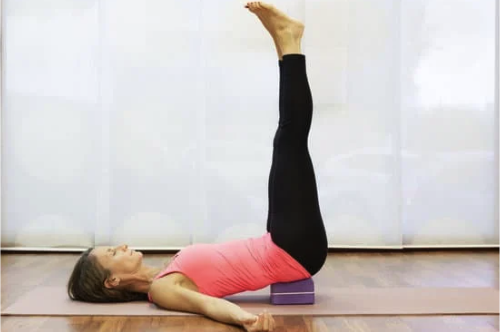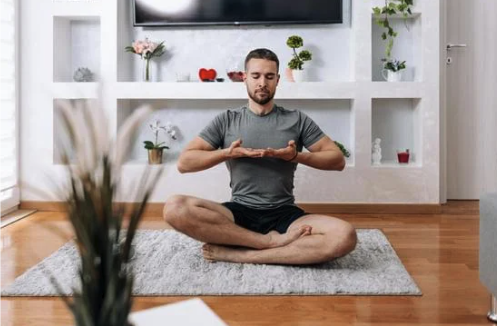written by Amilia Edwards
In today’s fast-paced and demanding world, stress has become a common occurrence. The constant pressures of work, relationships, and other responsibilities can affect our mental and physical well-being. Fortunately, yoga offers a holistic approach to stress management, providing us with a toolkit of poses and techniques that promote relaxation, mindfulness, and inner peace. From grounding poses that anchor us in the present moment to breathwork techniques that cultivate mindfulness and from the soothing power of meditation to the therapeutic benefits of guided visualization, each facet of yoga offers a unique pathway to stress relief.
Stress affects both our minds and body, leading to a range of health issues such as anxiety, insomnia, and even chronic conditions. Scientific studies have demonstrated the positive impact of yoga on stress reduction. One study [1] investigated the effects of yoga on stress and found that regular yoga practice significantly reduced stress levels among participants. The research highlighted yoga’s ability to modulate the stress response system. Additionally, yoga practice leads to a reduction in cortisol levels, a hormone associated with stress, indicating the physiological benefits of yoga for stress management. Through a combination of physical postures, breathing exercises, and meditation, yoga helps calm the nervous system and enhance overall well-being.
Grounding Poses for Relaxation
Child’s Pose (Balasana):
This gentle resting pose encourages deep breathing and reflection while allowing you to surrender and release tension. It relaxes the body and mind by stretching the lower back, hips, and shoulders.

Legs-Up-the-Wall Pose (Viparita Karani)
A study [1] that investigated the effects of the Legs-Up-the-Wall Pose (Viparita Karani) on stress and sleep quality found that this restorative pose significantly reduced stress levels and improved sleep quality, highlighting its potential therapeutic benefits. This soothing pose promotes relaxation by reversing gravity’s effects, easing fatigue, and boosting circulation. It also soothes the nervous system and alleviates anxiety.

Breathwork Techniques for Mindfulness
1. Alternate Nostril Breathing (Nadi Shodhana)
This simple yet effective approach balances the left and right hemispheres of the brain, soothing the mind and relieving tension. It involves closing one nostril gently while inhaling and exhaling through the other, alternating sides. A systematic review [2] examined the effects of pranayama (yogic breathing exercises) on stress and anxiety. The review concluded that Pranayama practices effectively reduce stress levels and enhance overall well-being.

2. Deep Belly Breathing (Diaphragmatic Breathing)
Shallow breathing is often associated with stress and anxiety. Deep belly breathing focuses on diaphragmatic expansion, allowing for deeper, more relaxed breaths. It promotes tranquility by activating the body’s relaxation response. A study [3] explored the impact of diaphragmatic breathing on stress and cognitive function. The results indicated that deep belly breathing techniques activated the body’s relaxation response, leading to reduced stress levels and improved cognitive performance.

Nurturing the Mind-Body Connection
In addition to physical postures and breathwork, guided visualization is a powerful technique that harnesses the mind-body connection to reduce stress. The results of a 2019 study [4] showed that guided visualization used on a regular basis considerably decreased stress levels and improved the individual’s general well-being. We can make our brains a tranquil haven by immersing ourselves in uplifting and relaxing mental imagery, which will reduce stress and encourage relaxation.
Gaining Inner Peace Through Meditation
Mindfulness Meditation
Mindfulness is the practice of bringing one’s attention to the present moment without judgment. It cultivates a sense of awareness, allowing us to observe our thoughts and emotions without getting caught up in them. Regular mindfulness meditation reduces stress, enhances emotional well-being, and improves overall mental clarity.
Loving-Kindness Meditation
LKM is a style of Buddhist meditation that seeks to cultivate unconditional kindness toward oneself and others. In general, practitioners silently repeat mantras toward their targets. In certain cultures, the mental image of the targets is also visualized to aid in the development of intentions. But, What does it mean? (1) Loving-kindness, which refers to unselfish friendliness; (2) compassion: concern for others’ wellbeing; (3) appreciative joy: being joyful for others’ successes; (4) equanimity: having a calm temperament in difficult situations. By cultivating feelings of love, kindness, and empathy, we can counteract stress, improve relationships, and enhance our overall sense of well-being.
Incorporating yoga into our lives can be a transformative tool for stress management and self-care. Grounding poses, breathwork techniques, and meditation practices provide a solid foundation for finding inner peace and balance. Through the practice of yoga, we can cultivate resilience, nurture our well-being, and ultimately find a sense of inner peace amidst life’s challenges. As we embark on this journey, let’s remember that yoga is not merely a physical practice but a mindful and soulful exploration of self-discovery. Through the integration of yoga into our daily lives, we can cultivate a deep sense of inner peace, enhance our well-being, and navigate the ebb and flow of life’s challenges with grace and equanimity.



